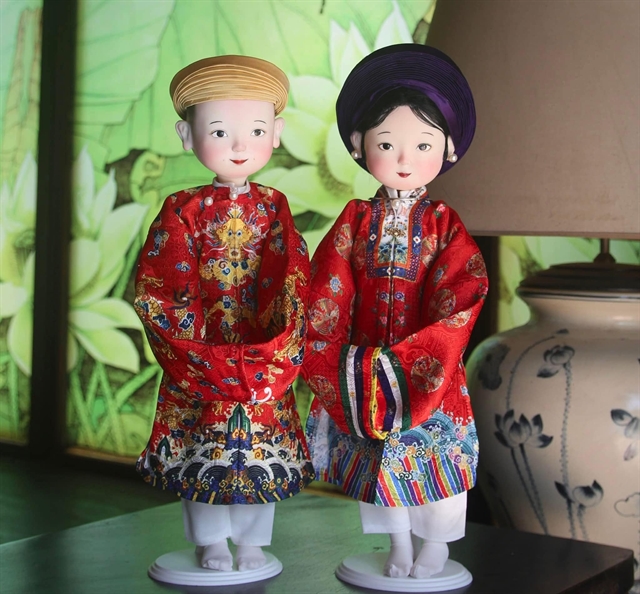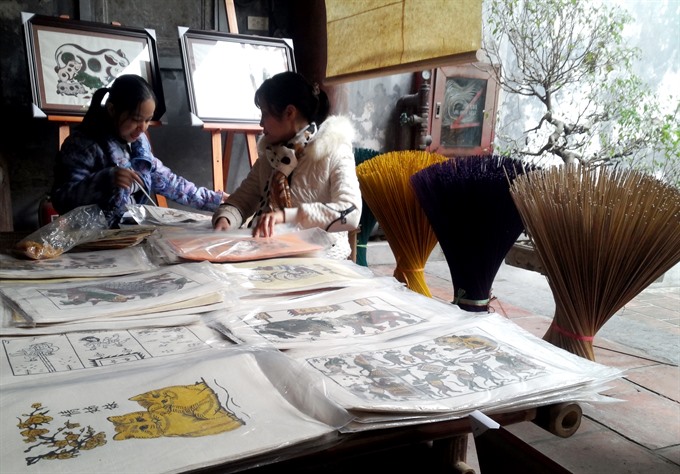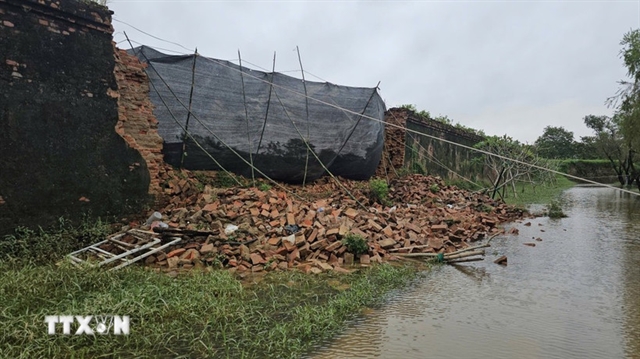 Features
Features

The Red River Delta civilisation, original home of the Việt people, has developed strong cultural aspects, such as Bắc Ninh Province’s Đông Hồ folk paintings of babies and farm animals, and Hà Nội’s Hàng Trống woodcuts of heroic figures, such as Trần Hưng Đạo repelling the Mongols.
 |
| Delicate work: Artist Đào Đình Trung performs his brush stroke on a Kim Hoàng painting at Hà Nội Centre for Cultural Exchange, 50 Đào Duy Từ Street, Hà Nội. — Việt Nam News Agency Photo Đinh Thuận |
by An Vũ
The Red River Delta civilisation, original home of the Việt people, has developed strong cultural aspects, such as Bắc Ninh Province’s Đông Hồ folk paintings of babies and farm animals, and Hà Nội’s Hàng Trống woodcuts of heroic figures, such as Trần Hưng Đạo repelling the Mongols. However, much of the skills have been lost, largely because younger people show less interest in the rural and historic past.
But there is one national artistic treasure which is on the path to restoration, Kim Hoàng painting. Kim Hoàng (golden-made) painting, is a common name given to folk painting invented in the second half of the 18th century and strongly developed since the 19th century at Kim Hoàng Village, Vân Canh Commune, in Hà Nội’s suburban district of Hoài Đức. It can be said to be a blend of both old styles.
The subjects in Kim Hoàng paintings are taken from the plain and ordinary lives of the citizens of the Red River Delta, so they easily win people’s hearts. Each painting has familiar sights of animals as swell as epicting local daily life, Lunar New Year holidays and worship of the Kitchen Gods.
According to Sách Đồ Họa Cổ Việt Nam (The Ancient Graphic Arts of Việt Nam), ancient Kim Hoàng village comprises mostly residents who migrated from the central province of Thanh Hóa to the North in the early 1700s. They united the two villages of Kim Bảng and Hoàng Bảng.
Aware that the modern Hàng Trống and Đông Hồ paintings were mostly sold at markets in Hà Nội, Bắc Giang, Bắc Ninh and Hải Dương, and were then not favoured by farmers because of their high price, the residents of Kim Hoàng were determined to create a new style, which combined the techniques and fine arts of the two styles.
The Nguyễn Sỹ and Nguyễn Thế families were pioneers in Kim Hoàng painting, which flourished in the 19th century. But a flood in 1915 inundated all the villages of ancient Phùng town (now rural district of Hà Nội’s Đan Phượng) to Cầu Giấy District, washing away printing blocks. Only a few original paintings survive, such as Phúc Mãn Đường (All of Good Fortune Come to the House), Rooster and Pig. They are at the Việt Nam Fine Arts Museum.
While Kim Hoàng combines the best of two kinds of paintings, it has more delicate, detailed lines than Đông Hồ paintings, and the colours arer as bright as that of Hàng Trống paintings.
In addition, Kim Hoàng has a special folk poem written on the left of the painting. While Đông Hồ uses paper covered with seashell powder and Hàng Trống uses poonah paper, Kim Hoàng is known as the "Red painting" for its use of red, pink or yellow paper.
The most noticeable trait of Kim Hoàng is that craftsmen use only one woodblock to print the black outline onto the paper, while the rest of the colour is filled in by the craftsman, making each painting a unique work of art.
What is left at Kim Hoàng Village, the birthplace of the painting, are memories of elders. Nguyễn Thế Nhuận, 92, chief of the Kim Hoàng communal house relic managing board, said that after the flood, only a few artists were left. The tough life forced people to forget the joy of collecting and hanging the paintings.
 |
| Traditional art: An art centre presents traditional folk paintings: Hàng Trống, Kim Hoàng and Đông Hồ. — VNS Photo Đoàn Tùng |
According to collector Nguyễn Thị Thu Hòa, director of Hà Nội’s private pottery and porcelain museum, and whose private collection has 60 Kim Hoàng paintings, she is joining hands with artists Nguyễn Đức Hòa and Trần Nguyên Đán to restore the carvings and folk paintings.
“If we fail to revive the paintings, there will be no traits of them left for posterity. Those who can remember them well are already 80 and 90 years old. The last time I came back to the village, I verified how to print the paintings and their colours. Luckily, a book by Maurice Durand, a French man, featuring many Vietnamese folk paintings, was reprinted, and I was able to successfully restore some of them,” said Hòa.
At present, the painting style has only one heir, artist Đào Đình Trung, 38, who was born in Kim Hoàng Village. Hòa noted his ability with folk painting and persuaded him to help her efforts. Lately, he has invented a new style of Kim Hoàng painting, using as his subject the flamboyant Nghê (kylin).
According to Hòa, the restoration project consists of three parts. “What makes this painting unique is its childish but vivid brush strokes. Firstly, we will restore 50 old samples (with reference to the document from the book Imagerie Populaire Vietnamienne by Durand reprinted in 2011),” she said.
Describing the paintings, Hòa said that the contents of the 50 existing Kim Hoàng paintings were mostly stories of human life, with only four paintings of chickens and pigs. All of them are printed on paper with a typical red-orange background, using simple and delicate strokes and often with three more colours: white, light green and purple. Kim Hoàng is also called the Red painting. Red is the colour of Tết (Lunar New Year).
There were various ways to print the paintings in the past. But now they are printed with the woodblocks lying with the engraving surface upward. The lines are printed and colours are added by hand.
Hòa designed 10 samples whose images relate to those carved on the Kim Hoàng communal house, and painter Đán has produced 10 samples based on boat themes, Hà Nội and Hội An.
"Another task is finding a plot of land in the village for our studio. The city’s culture and trade authorities have been asked to help with finance. This year, we hope to publish 25 folk paintings as a method to reserve this unique cultural legacy,” Hòa said. — VNS




